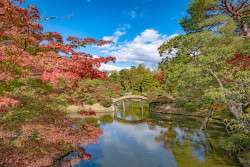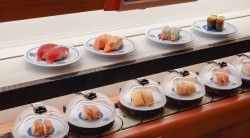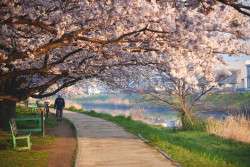
April 13, 2006
The Scalding Pools
Hell on earth can be found in Beppu, a must-visit for fans of Japanese onsen
By Metropolis
Originally published on metropolis.co.jp on April 2006

Photos by Stephen Mansfield
Sail into Beppu Bay for the first time, and the city and its rooftops, the slopes of the mountains at its rear, appear to be pincushions for dozens of white, helium-powered, feather dusters.
Sprays of iron sulphide, gurgling alum and burping mud, the very vision of Hades, may seem oddly tuned to the concept of vacationing, but for many years after World War II, in the days before Cairns and Hawaii became popular vacation spots, Beppu, along with Miyazaki to the south, was one of Japan’s most popular and exotic honeymoon destinations. Even the exceptionally well-travelled Yukio Mishima and his bride Yuko spent their honeymoon in Beppu. The city is no longer a fashionable resort—though it remains a much-visited one—but it does have a kind of authority among hot springs.
Along the dividing line between fire-infused earth and water are intermediary states, promenade hot springs, beachside suna buro (sand baths), and the bay itself, where hot water bubbles up through seabed fumaroles, creating a small biosphere where radiantly colored fish, swimming up from the South Seas and normally driven away by the cooler waters of the “black current,” have discovered a warm lagoon. Because of its trade winds Beppu is relatively cool in summer and warm in winter. Monkeys, partial to southern climates, are said to swarm in the mountains behind the city, though I saw no evidence of them during my stay. Nor of their supposed species-atypical habit of sauntering down to the sea, jumping in and swiping fish.
Willard Price, in Journey by Junk—his engaging, thoroughly exaggerated account of traveling through Kyushu—wrote that Beppu was “built upon the roof of the infernal regions—stamp too hard and your foot may go through the thin crust and come out parboiled.” Visitors, most of whom sensibly stick with the “Jigoku-meguri” (“Onsen Hell Trail”), are less likely these days to get the soles of their feet scalded after wandering off into the mountains. Nor are they likely, as one traveler in the ’50s observed, to see “nomadic pilgrims boiling their rice over holes punched in the ground.”

The earth does seem unusually brittle here, though, and with good reason. Beppu’s porous skin is punctured by an innumerable number of vents from which steam continuously rises, making it feel at times like a huge, malfunctioning boiler room, all its valves and pipes threatening to burst at once. Scalding water surfaces not only at the city’s 3,000-plus water sources and 160 bathhouses, but also in private residences, where it’s piped in to heat homes, fuel ovens and warm up greenhouses that produce mid-winter cucumbers and muskmelons.
If you can accept its gimmickry and brazen commercialism, this glitzy, neon-strung hot-springs resort—a melange of pachinko parlors, love hotels, sleazy bars, and nightclubs, that’s visited by over 12 million tourists a year—constitutes an extraordinary thermal and entertainment roller coaster.
Most of Beppu’s sights are, obviously, connected in some way with the hot springs. The most celebrated are its jigoku (literally, “hell”), pools of mineral-colored water and bubbling mud. A circuit of the springs known as Nine Hells, seven of which are within walking distance in the old geisha district of Kannawa, reveals that each has a different function, color and mineral property.
Although the sand baths at the beach are all al fresco, Takegawara Bathhouse, one of Beppu’s oldest, is by far the more atmospheric way to enjoy a sand bath. The grand building dates from 1879, and most of the fittings and fixtures—time-worn wood and tile floors, sunken baths, banisters topped with bronze finials, soaring wood pillars, a roof as high as a church—remain intact. Everywhere you look, with the exception of the main bath, which admonishes patrons to spend no longer than three minutes at a time in the scalding water, there are timepieces from the last century, large grandfather clocks and round or oval white-faced pieces like giant wristwatches framed in walnut.

Entering the suna buro is a little like stumbling across a group of grave robbers at work. There are three or four figures in the gloom, each equipped with a shovel, vigorously disinterring a man from a burial mound of black earth. The figures turn out to be women of advanced middle age, or elderly matrons in blue smocks, the “corpse,” a much-resuscitated local resident who comes for a sand bath once a week.
Should you wish to try this form of immersion, a shallow pit will be dug for you before the sand is piled on top, head allowed to rest exposed on a towel. Any reservations about proceeding are scotched as a final slap to the top of the mound is delivered by one of the women’s spades. The substance feels more like black grit, something that could be used for construction work. This is quite different from the childhood novelty of being buried by a sibling on the beach. It is also, in its own way, far more invigorating.
The rituals of sightseeing may seem more dated in this old spa town when compared with other resorts, its simple offerings undermined by a newer, brasher style of tourism. But that, if anything, is reason enough to visit Beppu.
It’s easy to get to Beppu, either by plane to Oita Airport, train from Hakata and other points throughout Kyushu, or by ferry from Kobe, Osaka or Hiroshima. While there are plenty of standard and business hotels, it’s more fun to stay somewhere with a mineral bath. At the two ends of the economic scale, the Minshuku Kokage (tel: 0977-23-1753), with tatami and Western-style rooms, is just a couple of minutes on foot from the station. Rather more up market is Kannawa-en (tel: 0977-66-2111), a graceful old ryokan with a majestic landscaped garden in the Kannawa “boiling hells” district. Beppu is famous for its delicious flounder and blowfish, but also the more moderately priced dango jiru, a thick soup with white noodles, pork, vegetables and chicken. Matchan, a cosy restaurant in the station shopping arcade, is a good place to sample it. The full sand course (and other baths) at Takegawara Onsen cost ¥1,000, which includes a tenugui (small body towel).
[geo_mashup_map]







